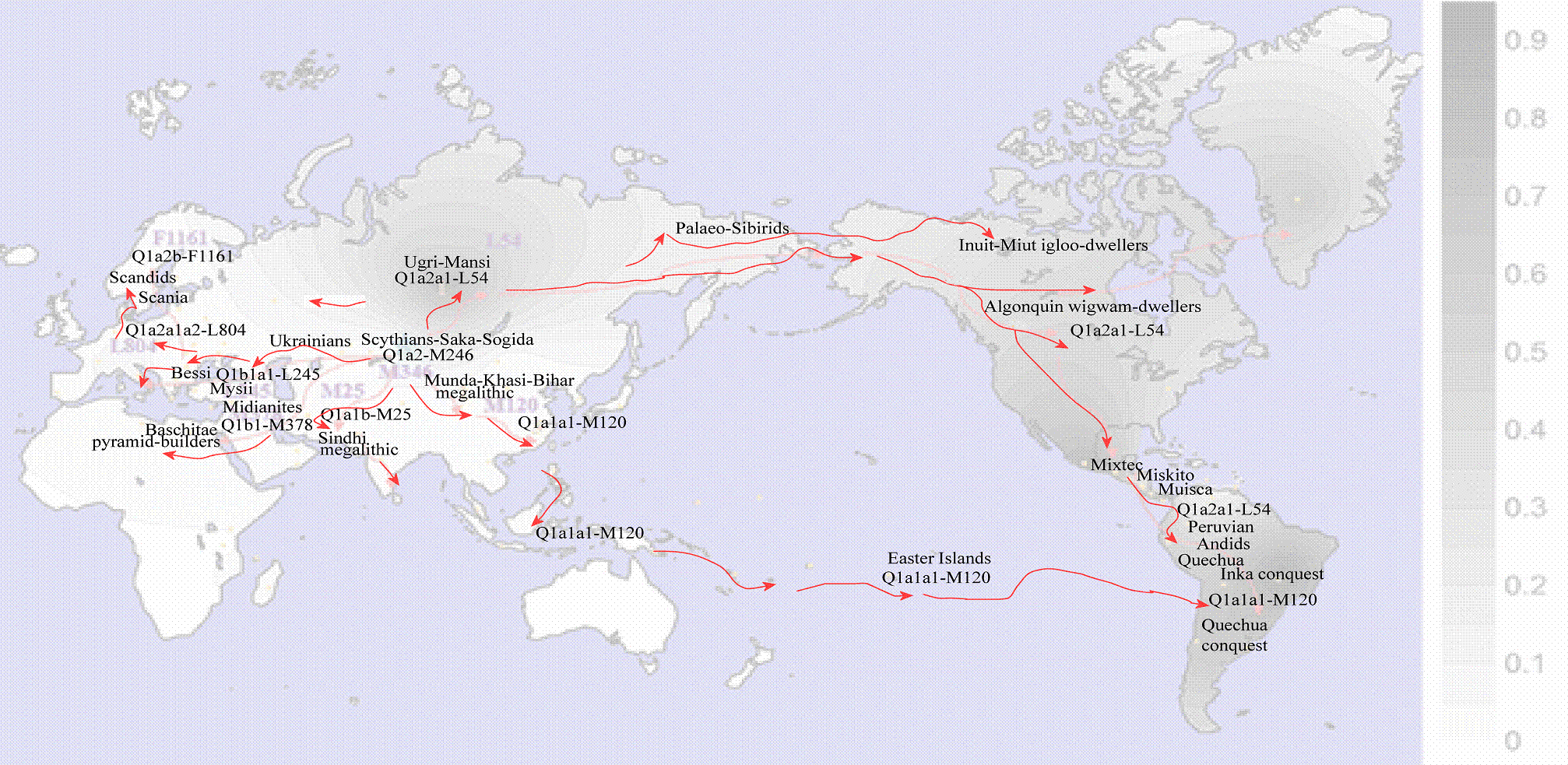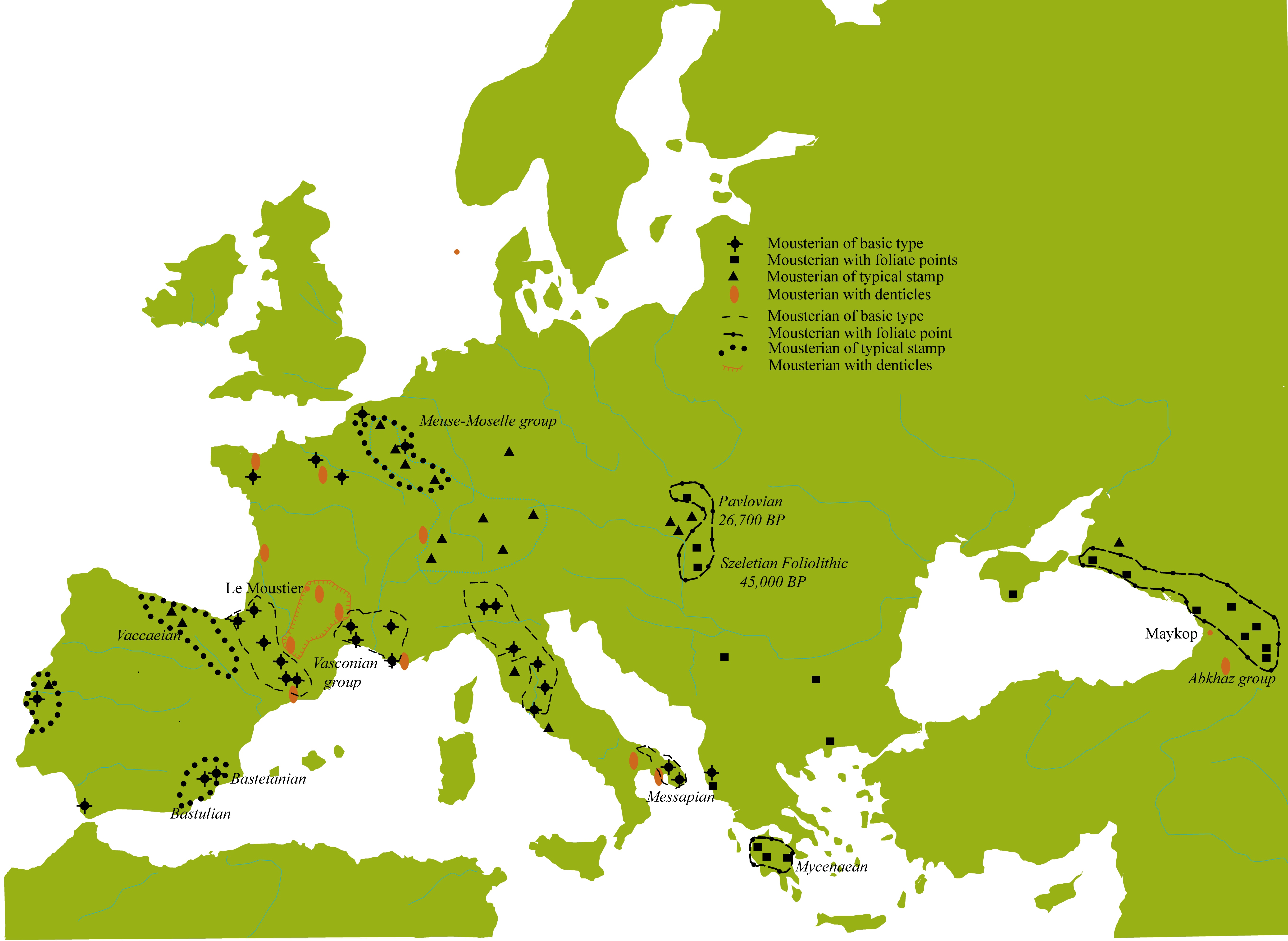|
|
The Basco-Ugro-Scythoid Y-DNA Haplogroup Q-M242
The genetic roots of the ancient
megalith-builders are hard to trace because of their incredible antiquity and
the degenerate state of conditions. Their monuments spread all over Eurasia and Egypt in the Bronze
Age as an expression of steep social differences in the earliest civilisations. Their common tribesmen had to put up with
less dazzling graves, with the corpse entwined with a long piece of cloth
under a pile of stones as is common among South African cattle-breeders. Huge
pyramids, cairns, tumuli, kurgans
and tholoi were all more luxurious derivates
of pile-burials used as a postmortal abode of the Khoekhoe tribes in Namibia.
Their Y-DNA haplogroup
Q-M242 became
surprisingly dominant in the New World and its cradle
land in Siberia but it has left only few
vestiges in the west of Europe. The reason is that their
populations exhibited scarce density and were superposed by later incomers
such as Gravettians, the Corded Ware with Y-hg I1
and the Magdalenian Microlithic with Y-hg R1b. In Africa it probably specialised as a new Y-DNA haplogroup
B common among the Khoekhoe, Maasai
and the Nilotic pastoralists.
This observation implies that the apparatus of population genetics pursues markers
of midrange outreach and leaves many empty gaps in links between the racial
varieties united by long-range genetic affiliation. For instance, it builds
no passable bridge between African Negrids,
Australian Aboriginals, Melanesians and Brazilian Amazonids.
Neither does unite piscivorous fishermen, their
nomadic hordes fall into the Pelasgoic haplogroup T in Africa and Europe, while their
Asiatic kinsfolk continued by developing a different haplogroup stock C-M130. A similar dichotomy appears
between African Hamitoid pastoralists
with the Y-DNA group B-M60 and their Asiatic Ugro-Scythoid
brothers with Q-M242.
The highest distribution of Q-M242 is evidenced in South America (100 %) and
some tribes of the Americas
(Apache 78 %, Mixe, Chibche
100 %). They all belong to the group Q1a2a1-L54 stemming from the Siberian Ugri-Mansi people. However, the Peruvians Andids look like a continuation of the Polynesian haplogroup Q1a1a1-M120. Their genetic connection confirms
Thor Heyerdahl’s theory that Peruvian Inkas sailed in balsa rafts and were able to reach
Polynesian islands. His view developed the earlier ideas of the diffusionist anthropologists G. Elliot
Smith and W. H. R. Rivers from the 1920s. They noticed that there
existed a number of striking cultural parallels between the architecture of
ancient Egyptian pyramids and the Aztecan and
Peruvian monumental megalithic buildings. In opposition to their
reconstructions of journeys undertaken by Egyptian mariners to Central America, Heyerdahl supported an alternative Polynesian hypothesis.
His expedition Kon-Tiki journey relied on the
nautical skills of balsa rafts. Their use was witnessed by Francisco
Pizarro's seafarers, who encountered balsa watercrafts constructed by
the Peruvian Inkas in 1526. Most Polynesians were Pulau-Tongans and employed catamaran boats as
their own specific means of trasport. The Bihar megalith-builders were of
different stock, they probably started their migrations in Burma and landed
on two large islands famous for megalith monuments, Mindanao and Sulawesi. These centres
launched further expeditions to the east. They propagated megalithic
architecture with huge statues, menhirs and
pyramids as far as the Easter Islands
and the Peruvian burial tombstones.
The migration routes of Ugro-Scythoid define also their principal tribal
divisions. The earliest migrations remain hidden to our eyes because they
took place in the Middle Palaeolithic and became
visible only in the excavation sites of the Mousterian Neanderthalers.
Their common traits were beehive huts out of straw or hides supported by
boughs, mammoth bones and whale ribs. They had low entrances that were often
prolonged by a corridor called prodromos in
Mycenaean tholos cairns.
The live sleepers usually did not lie on beds but relaxed in a sitting or
squatting position. The sitting posture was typical also of the dead warriors
buried in cairns and tholoi graves. The dead bodies were oiled by sacred
unction, mummified and entwined by a long piece of cloth.
|
|
The Ugro-Scythoid Nations with Megalithic Tumuli
An equally big chunk of
Eurasian ethnic culture was formed by the megalith people of Basco-Abkhazo-Scythoids. Their conquests invaded Europe in the Cyclopean Bronze Age whereas the Uralo-Sarmatians subdued European peasantry in the Iron
Age. In Central Asia they prided on the exclusive standing of Royal Scythians.
In China they took hold of reign when the Hsia dynasty crowned its king with the title wang. In ancient Greece the Mycenaean Cyclops installed the rule
of their king called wanax or wa-na-ka. They were notorious for the tall robust
physiognomy of ‘one-eyed’ brachycephalous giants
but as they often intermarried with wives from the shorter Celtic nations,
they stepwise lost most of their eccentric traits.
The Mycenaean Cyclopes adored as their
supreme god Uranos, whose twin brother is sought in
the Indian patron of herdsmen called Varuna. Their
name derives from the Scythoid phratry
of Ugrians and Ingrians. The reign of Uranos in the ancient Greek pantheon was recorded in
architecture by the Mycenaean tholos graves
and the Treasury of Atreus, whose tomb is
erroneously attributed to Atreus. Mycenaean tholoi were dome-shaped constructions guarded by
leonine sphinxes. The impact of Cyclopean architecture was felt also in Athens, whose central
town-hall was described as tholos. In front
of its doors was a circular meeting-place and training-ground called agora.
The philosophy of circular cupola-shaped constructions found an echo in Stonehenge, its circle of
tall standing stones and the Arthurian ‘round table’ reserved for debates of
the council of elders.
|
Phratries
|
Scythians/Scots/Saka/Sogdians (stag) – Mysii/Mushkoi (felines, cats) – Basques/Abkhaz (lion) – Ugrians/Ugarites/Ukrainians
(capricorn) –
Mitannians/Medes/Magyars (eagle)
|
|
Ecotype
|
steppe
grassland, savannas, mountainous pastures, unconquerable hill-forts on high
promontories and rocky reefs
|
|
Nutrition
|
hunting the mammoth, buffalo and big mammals, breeding bovine
domestic cattle, military crafts, slave-holding, blood-letting
|
|
Dwelling
|
beehive huts
and houses with a low entrance, circular cupola-shaped stone house tholos, arched vaulting, dome-shaped roofage
|
|
Cult
|
totem cults of
feline ancestors, leonine sphinxes, worshipping Ahura
Mazda, Mithra, Uranos
and Varuna, dualism recognising good and bad
angels, later it transformed into monotheism, golden masques for kings,
golden effigies of stags and lions
|
|
Burials
|
mummifying the dead corpse of prominent persons, greasing the corpse
with sacred ointment, winding it with a bandage of a long cloth and
deposing it in a domed-shaped cairn tholos
with a low horizontal entrance (prodromos);
cairns were covered by huge heaps of stones, similar Scythian
kurgans, Balkan mound tumuli graves, Scottish cairns and
Anatolian mausolea
|
|
Death
|
Scythoid megalith-builders
believed in solar and ocular magic, they used it to measure the incidence
of sun beams; evil curses were pronounced by maledictions and evil-eye
casting
|
|
Visage
|
robust tall giant stature, brachycephalous
skull, aquiline nose, light reddish skin, red hair
|
|
Weapons
|
Mousterian flake tools with repeated retouch, leaf-shaped points
fixed to the head of lances (lanceoliths), bronze
daggers, bows with an arrow as prototypes of stringed instruments
|
|
Clothing
|
leather mantle
from hides tied with a clasp and tossed over the left shoulder so as to let
the right arm free for throwing spears
|
|
DNA
|
ABO group O, Rh-, Y DNA haplogroup Q, mtDNA haplogroup A or X
|
|
Poetry
|
alliteration,
initial consonance, heroic chants, heroic epic sung to the lyre, harp, lute
and other stringed musical instruments, evil-eye charms
|
|
Tongue
|
agglutination,
incorporation, vowel ǝ, alternating b - m, fricatives þ,
θ, γ, χ, k-duals, k-plurals,
definite articles, OSV order
|
Table 1. The cultural paradigm of
megalith-builders
Megalithic stone monuments
derived from straw beehive-dwellings with a low entrance and finally resulted
in Anatolian mausolea, Scottish cairns and Islamic mosques.
Their earliest archetype is seen in the Mousterian mammoth bone huts at the
site Molodovo I. Their occurrence spanned from the Chukchee yaranga constructions
to African cattle-breeders and reached as far as the Khoisan
beehive hut matjieshuis from boughs, straw and cow-dung. The Khoisan camps with beehive huts were surrounded by a
circular enclosure for cattle called kraal. The end points of this
long Mousterian migration route are now remarkable for languages with
analytic constructions, indefinite and definite articles, collective plurals
in -t and distinctive duals in -k.
When the rule of Uranos
in archaic Greece broke down and
his throne fell prey to Kronos, the power of
Cyclopean nobility inhabiting round castles weakened and gave ground to the Titanids from the kin of Graikoi
headed by Cronos. New inhabitants of the Myceanaean acropolis began to bury their dead in
shaft-graves and cist-tombs. The Mycenaean civilisation cannot be associated
with Greek etymologies, its warrior class colonised a long belt of land
leading from the Mushkoi on
the Euphrat to Mysia in Anatolia and to the Bessoi and Mysians in Thrace. Its ancestry in
Sumerian Ur, Anatolia, Thrace and Scythia Magna in the Ukraine can be discerned
according to rich golden treasures with royal golden masques, golden effigies
of stags and leonine or feline divinities symbolising main Scythoid phratries in Table 27.
The Iranian Medes professed Zarathustra’s religion of Zoroastrism. Its celestial hierarchy attributed the
highest position to their clan ancestor Ahura
Mazda. The role of evil devil was entrusted to Ahriman,
whose name is associated with Aryans. But it is more probable that it hinted
at Angra Mainyu or Ahriman, the
ancestor of all Ugrids. Nations on the Indian
subcontinent prayed to four principal deities Varuna,
Mithra, Nāsatja and Indra. Their names allude to
their doppelgängers revered in the kingdom of Mitanni. Ancient records spelled their names as A-ru-na, Mi-it-ra, Na-ša-ti-ya and In-da-ra. Mazda Mithra and Vishnu were good sun-gods
adored by Medes, Varuna and Angra Mainju were evil gods
worshipped by the Ugric moiety of Scythian and
Sindhian megalith-builders.
|
|

 `
`
